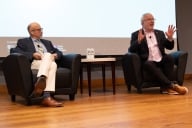You have /5 articles left.
Sign up for a free account or log in.
Last fall, Abilene Christian University gave out free iPhones or iPod Touches to its first-year undergraduates as part of an attempt by the Texas college to transform its campus into a 200-acre Petri dish for studying the intersection of mobile technology and higher education. Now, the reviews from the first year of the experiment are in — and they are glowing.
In the university’s 2008-2009 Mobile-Learning Report — a 24-page glossy prepared for the university’s board of trustees — Scott Perkins, a psychology professor and director of research for the mobile initiative, writes that “iPhones present a more attractive platform for learning” than current classroom tools, and “learning activities can be successfully transitioned to mobile-device platforms.” Furthermore, 89 percent of students and 87 percent of faculty polled called the program successful.
While the Web, wireless technology, and portable computers transformed the way students can access information, mobile devices can take those tools a step farther, said William Rankin, an associate professor of English and director of educational innovation at Abilene Christian. Rankin noted that he teaches a course about the range. “Where do I teach that class? In a classroom,” he says. “I always have to simulate things. Now I can go out into the field.” With mobile devices that are connected to the Web, he continued, students can leave the classroom without forfeiting their ability to take notes and photographs and look up information on the Web. And when he wants to make sure everyone is focusing, Rankin said, he can instruct students to pocket their handhelds — something that many professors wish they could do with laptops.
The Abilene Christian project has been viewed by some as a gimmick, similar to Duke University’s widely publicized 2004 decision to give each member of its incoming class an iPod -- a program it quickly changed to encompass only certain students, then changed again to a partially subsidized purchase opportunity. Although Rankin said he thinks the Duke experiment was a success, it left many stones unturned. “Duke gave out the devices like they were sowing seeds in a field,” Rankin said, “saying, ‘Let’s see who does something with them.’”
Abilene Christian’s approach is more active: Give students the mobile devices, then have professors integrate the machines and their tools into the way courses are taught, and measure the changes.
Chemistry instructor Cynthia Powell, for example, created a special section of 25 iPhone users to whom she delivered laboratory preparation and safety lectures via podcast, rather than giving them in the classroom. Then she tracked the performance of that section relative to her 109 other students in the five categories she uses to determine grades. While the higher scores of the mobile group were not outside the substantial margin of error, Perkins said the mere fact that there was no decrease in score was evidence that such instruction “can transition to a mobile platform with no loss in student mastery of content.”
Powell’s experiment, however, demonstrates the current limitations of Abilene Christian’s mobile learning study. Because the experiment took place on such a small scale, the margins of error were sometimes as high as 13 points, making it impossible to render statistically significant findings. Part of the problem, Abilene officials pointed out, is that they’ve only been giving away free devices for a year; it’s hard for a professor-researcher to wrangle a decent sample size when only a quarter of students have the technology, and professors are reluctant to adapt their courses to a mobile platform when not all students are able to participate.
Although the university plans to saturate the 4,000-student campus with iPhones and iPod Touches by the fourth year of the study (giving them out to each incoming class), even then it will be difficult to extract good data, said Perkins, the lead researcher. “We could do this study for 10 years, and then maybe we could talk about statistical significance,” he said. “That’s just simply a function of the sample size.” In order to generate data that would comment widely on the uses and effectiveness of mobile technology on campuses, Perkins added, the study would have to partner with other institutions.
That is exactly what Abilene Christian is hoping will happen. Campus officials are hoping to leverage the publicity they have gotten as a result of the study to broaden the project beyond university's own borders. “We’re looking for some standardization with the measures and sharing of results,” said Perkins, so the study might collect data “more widely and on a more robust scale than would be possible at any one school.”
In the meantime, the faculty “mobile learning fellows” are working with what they’ve got, and have kicked off a handful of new research projects — mostly geared toward applying mobile technology to the teaching of various disciplines — and seeing what happens. At this stage, Perkins said, the priorities are to get more professors teaching with mobile tools across more disciplines, and designing more sophisticated experiments — ones that rely less on opinion surveys and more on hard data that is truly capable of commenting on cause-and-effect.
For all the attention it has generated for the Texas university, the mobile learning study has been a relatively cheap investment, said Phil Schubert, Abilene Christian’s executive vice president. One concern, he said, was expanding wireless coverage to accommodate Internet use outside the dorms and classrooms. Since not all the students could necessarily afford AT&T service plans for their iPhones, and U.S. tax law would not permit the university to subsidize service plans for its students, Abilene Christian offered students the alternative of an iPod Touch — a device that shares many of the iPhone’s functions, but requires a wireless network to support Web-surfing. In order to make things equitable for the iPod Touch crowd, Abilene upped the number of wireless network access points on its 200-acre campus to 590.
“We probably spent a half a million dollars building out our infrastructure,” Schubert said. Beyond that, there was the cost of the roughly 3,000 devices, which averaged $250 or $300 each. “That’s not an extremely significant cost in the scope of a $100 million budget,” Schubert said. He said the university has received no sponsorship from Apple or AT&T.








